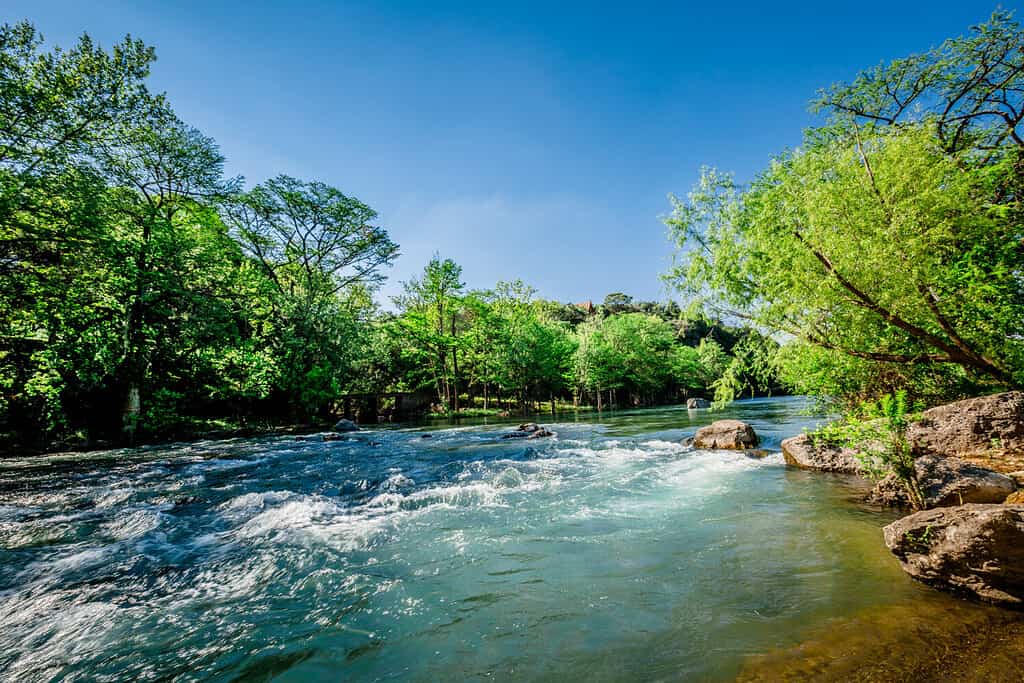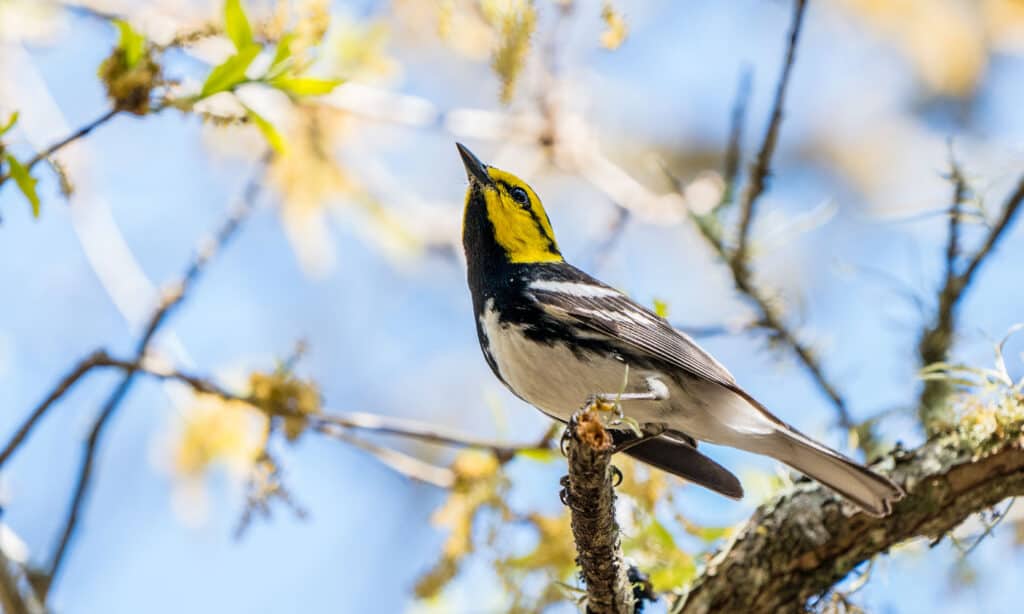Passing both San Antonio and Austin, the Guadalupe River runs nearly 250 miles southward from its origin in the Texas Hill Country. From near Kerrville, it stretches through Central and Southeast Texas on its journey to San Antonio Bay in the Gulf of Mexico. The river picks up water from several tributaries along the way, including the Comal River, the San Marcos River, and the San Antonio River. It also receives water from many minor tributaries like Honey Creek, which runs just north of San Antonio.
About halfway along its course, in New Braunfels, the Canyon Dam divides the Upper Guadalupe from the Lower Guadalupe. There, the U.S. Army Corps of Engineers monitors and controls the flow of the river’s southern stretch. From season to season, the river’s water levels and discharge rates can change drastically. Prolonged, heavy rains can transform a gentle flow into one that moves thousands of cubic feet per second.
While the climate along the river varies across its entire course, its waters tend to stay pretty consistent in temperature. At a cool average of 64 degrees Fahrenheit, the Guadalupe tempts passersby for a swim during the searing heat of a Texas summer. But is it safe to jump in?

The water of the Guadalupe offers a crisp, cool contrast to the usual high-nineties of a Central Texas summer.
©JaDipity/Shutterstock.com
Is It Safe to Swim in the Guadalupe River?
Yes, many places along the Guadalupe are safe for swimming. One spot, Kerrville’s Schumacher Crossing, often ranks among the best swimming holes in all of Texas. Just south of the historic Schumacher ranch, the crossing today features a picnic area and a launch site for tubes, rafts, and kayaks. The water there is gentle most of the time thanks to John Randolph Schumacher, who constructed several rock walls and dams in the 1920s to serve as a river crossing and reduce floodwater impact downstream.
Further down the river, about 30 miles north of San Antonio, sits the Guadalupe River State Park. Like Schumacher Crossing, it is a popular destination for both locals and tourists as summer temperatures soar. The park gives visitors access to four miles of riverfrontage where, in addition to swimming, they can fish, kayak, tube, and canoe. There are also plenty of opportunities to hop off the water and hike or ride mountain bikes through 13 miles of trails. For those who want to spend more time on the water, the state park features 85 drive-up campsites with access to both water and electricity. Nine more campsites, for tents only, await adventurous visitors further down the beaten path.
While water quality along the river can change seasonally, it is frequently very good. The biggest fluctuations in quality occur due to bacteria such as E. coli after flooding or heavy storms. The Guadalupe is also liable to exceed its banks after prolonged periods of rain. Though the Canyon Dam controls the river’s flow, a large influx of stormwater can sometimes make the river unsafe for recreational activities. If you’re planning a swimming trip, it’s always a good idea to check local river conditions!
Guadalupe River Wildlife
Rivers are hotbeds for biodiversity and the Guadalupe River is no exception. Regardless of where you are along its course, one of the best things to do is simply kick back and observe the local wildlife. You’re sure to witness many incredible animals in their natural habitat, including some endangered species.
Mexican Free-Tailed Bat (Tadarida brasiliensis)
One of the most interesting animals you’re likely to encounter is the Mexican free-tailed bat (Tadarida brasiliensis). These tiny, migratory bats spend most of the year flitting about Texas searching for food and preparing for their mating season. As evening arrives, they dart back and forth above the Guadalupe, feasting on the countless flying insects that reside there. The insects don’t stand a chance — Mexican free-tailed bats are among the fastest bats worldwide, shooting through the sky at up to 60 miles per hour! With their incredible speed, these bats can travel up to 100 miles in a single night in search of food.

With their tiny, slender bodies and sleek fur, Mexican free-tailed bats are built for speed.
©U.S. Fish and Wildlife Service Headquarters / CC BY 2.0 – License
Golden-cheeked Warbler (Setophaga chrysoparia)
Bats aren’t all that’s out there, of course. Depending on the time of year, you may also get to see the golden-cheeked warbler (Setophaga chrysoparia). From March to July, they build nests from spider webs and strips of bark in the mixed ashe-juniper and oak forests of Central Texas. Female warblers lay 3 or 4 eggs at a time during the nesting season, departing for Mexico and Central America once the young have reached adulthood.
These striking little birds are very easy to identify as they hop through the canopy in search of prey. Both sexes have a bright yellow face with a single black stripe that strikes through the eyes. The rest of their plumage is stark white and black, with males tending to have much higher contrast in their patterning. If you manage to see one along the Guadalupe River, consider yourself lucky. The golden-cheeked warbler is a true Texas native, nesting nowhere else in the world!

The endangered golden-cheeked warbler is a stunning sight — one that can only be seen in Texas early in the year.
©Michael Armentrout/Shutterstock.com
Guadalupe Bass (Micropterus treculii)
While most are probably familiar with the largemouth and smallmouth bass, they may never have seen the Guadalupe bass (Micropterus treculii). This species is a close relative of the two more common black bass species but appears only in the state of Texas. It favors the fast-moving waters of the Guadalupe, unlike its cousins who prefer to hunt in calm or still waters.
The Guadalupe bass can be difficult to identify without a close look, especially to the uninitiated. While its shorter jaw helps distinguish it from the largemouth bass, its coloration is key for a successful identification. Its color extends much further down its body than that of the spotted bass and the black parts of its pattern do not form vertical bars as they would on a smallmouth bass. Color isn’t always a dead giveaway, however, as the Guadalupe bass readily hybridizes with other Micropterus species.

The rare Guadalupe bass is endemic to the Edwards Plateau and widely inhabits the Guadalupe River.
©Clinton & Charles Robertson from Del Rio, Texas & San Marcos, TX, USA / CC BY 2.0 – License
Bald Cypress Tree (Taxodium distichum)
A prominent feature of the Guadalupe River is the gigantic bald cypress trees (Taxodium distichum) that line its banks for miles on end. These conifers are among the longest-living trees on Earth. On average, a bald cypress will live to see 600 years. The oldest one in eastern North America, however, is more than 2,600 years old! Over their incredible lifespan, bald cypress trees provide important food and habitat for wild turkeys, squirrels, eagles, and osprey. Beneath the river’s surface, their knobby knees slow water flow and give cover to a multitude of fish species.

The powerful trunks and knees of the bald cypress stabilize banks, help regulate water flow, and provide cover to many aquatic animal species along the Guadalupe River.
©Ben Nissen/iStock via Getty Images
Bald cypress trees aren’t bald for most of the year. Throughout the spring and summer, they are covered in flat, feathery needles. They earn their name for the shedding of their needles in fall — an odd trait for a conifer. There are only about 20 other conifer species in the world that do this! Bald cypress trees have very dense, hardwood that is similar to that of the yew tree. Because of their great longevity and the density of their growth rings, the oldest bald cypress trees can provide us with great information on the climate history of the areas in which they grow.
The photo featured at the top of this post is © iStock.com/TriciaDaniel
Thank you for reading! Have some feedback for us? Contact the AZ Animals editorial team.






